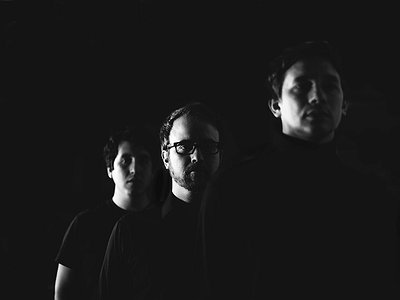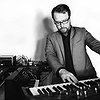Part 2
How do you make use of technology? In terms of the feedback mechanism between technology and creativity, what do humans excel at, what do machines excel at?
Everything we don’t bring into the world with us is technology. Our clothes are technology, cooking utensils are technology, a cat litter box is technology. To live is to use technology.
To me the importance of the interface, the feedback mechanism, is that you can fool with the technology until it presents you with something you can’t deny. Then you have a dialog with that something and mold it into what constitutes a new work. I enjoy the push and pull between human and machine. It’s that tension that I find attractive. That’s what electronic music is all about and I guess is what attracted me to it to begin with.
Machines excel at reproduction, at repeating things endlessly. This is what makes some Pop Art meaningful for me. Warhol’s work points out that the idea of infinitely repeatable and immutable simulacra is flawed. Any reproduction is inherently different from the one before and the one after. Repetition is a form of change. If repetitions happen often enough, consistently enough, we cross a threshold and notice changes in the repetitions and changes in ourselves. Subject and object are in a never ending temporal dance. Always in motion the future is.
Production tools, from instruments to complex software environments, contribute to the compositional process. How does this manifest itself in your work? Can you describe the co-authorship between yourself and your tools?
I think I touched on this before, but I always want my interaction with my tools, whether hardware or software, to be a bit like a chess match. I shouldn’t always know what my opponent’s next move will be. There should be an element of unpredictability between human and machine. What’s exciting to me is having a piece of gear I’m not totally familiar with, or another human being, in the equation so I'm never totally certain what will come next.
Collaborations can take on many forms. What role do they play in your approach and what are your preferred ways of engaging with other creatives through, for example, file sharing, jamming or just talking about ideas?
I actually consider myself a collaborator above all else. Coupler may have begun as a solo project but I’ve never really thought of myself as a solo artist.
I like to take a “you do you” approach to collaboration. If I have to tell someone what to do then we probably shouldn’t be working together. I never want to be the best musician/artist in a room. If I am, there’s little room for improvement or growth.
I’ve done a bit of file sharing though I can’t think of much collaborative fruit that has born just yet. As an improviser, it’s always good to sharpen those skills with others. And there’s not much I love more than talking about ideas. Coupler does a lot of “team building”. I think Conny Plank’s approach is our template. I heard a story about him working with DAF on their first record. They spent days upon days just talking and eating and drinking before recording the entire record on the last day. I like this way of working.
Could you take us through a day in your life, from a possible morning routine through to your work? Do you have a fixed schedule? How do music and other aspects of your life feed back into each other - do you separate them or instead try to make them blend seamlessly?
I have a difficult time compartmentalizing and I think this is sometimes to my detriment. I need to get better about separating tasks in time. On a good day I’ll wake up, do some stretches and exercises while making coffee and doing dishes and go to the piano for 15-30 minutes. The days that I play piano in the morning are almost always better for me. It really tunes my brain up in a nice way. I don’t have a fixed schedule currently though sometimes I wonder if I should. When working on a mix, remix or writing some new material I tend to work at home. In Nashville I had a discreet studio space but in Chicago I just use the apartment. I tend to do as much mixing as I can at home. I’ll then transfer things to a studio for a final mix.
Could you describe your creative process on the basis of a piece or album that's particularly dear to you, please? Where did the ideas come from, how were they transformed in your mind, what did you start with and how do you refine these beginnings into the finished work of art?
The last track on Gifts from the Ebb Tide, “INVENTION 4: Silenzio (or Sadak in Search of the Waters of Oblivion)” has a good story and for me has become the essential Coupler track. When working on the HeCTA record The Diet I got into a lot of dance music and wanted to wed the 12” single ideas of disco/italo/techno/Chicago house/acid house to the side long modal jazz workouts of Miles Davis electric period, specifically “Shhh/Peaceful” from In a Silent Way. I’d had the idea in my head for a while and messing with the Korg Monotribe one day it all just started to happen. So I improvised for about 18 minutes with the machine (the length of time you can get onto one side of a 12” played at 33 ⅓ before the sound quality starts to degrade) before adding two Korg drawbar organ tracks and two Fender Rhodes tracks. The rest came later. I tend to improvise a lot when I’m recording and then edit later for refinement. When I learned that this was how Can worked as well as how a lot of the Miles Davis records from the electric period were made it really opened me up and validated what I’d already been doing intuitively. So after all the improvising that went into the rough sketch of “Silenzio” I added more instruments, some Popol Vuh-inspired Mellotron, a melodic Opus 3, reinforced the Monotribe kick and snare. I then had the other guys add some touches. Matt Glassmeyer added some wonderful tenor saxophone, also improvised; Rollum Haas added a synth that includes the beautiful melodic bassline in the bridge; Rodrigo Avendaño added treatments that give parts of the track spatial depth. Throughout this process there was a constant push and pull of improvisation and composition, recording and mixing, adding and subtracting. It’s all one process.








